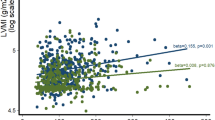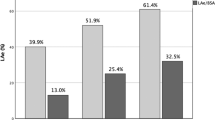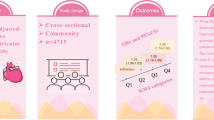Abstract
Several studies documented an association between metabolic syndrome (MetS) and left ventricular (LV) hypertrophy. However, only in a few of these studies the impact of MetS on left ventricular mass (LVM) was separately analysed by gender, with conflicting results. The aim of our study was to verify, in a wide sample of essential hypertensive patients, the influence of gender, if any, on the relationship between MetS and LVM. We enrolled 475 non-diabetic subjects (mean age: 46±11 years), with mild-to-moderate essential hypertension, of whom 40% had MetS, defined on the basis of Adult Treatment Panel III (ATPIII) criteria. All the patients underwent a 24-h ambulatory blood pressure monitoring and an echocardiogram. LVM indexed for height2.7 (LVMH2.7) was significantly (P<0.001) higher in women with MetS (n=83) than in those without it (n=97; 54±17 vs 42±11 g m−2.7). An equally significant difference in LVMH2.7 was documented also in male gender between the two groups with (n=105) and without MetS (n=190; 51±14 vs 43±11 g m−2.7; P<0.001). The relationship between MetS and LVMH2.7 remained statistically significant (P<0.001) in both sexes, in multiple regression analyses, even after adjustment for potential confounding factors. Our results seem to suggest that the relationship between MetS and LVM is not significantly affected by gender, being LVM increased in both hypertensive women and men with MetS.
This is a preview of subscription content, access via your institution
Access options
Subscribe to this journal
Receive 12 digital issues and online access to articles
$119.00 per year
only $9.92 per issue
Buy this article
- Purchase on Springer Link
- Instant access to full article PDF
Prices may be subject to local taxes which are calculated during checkout



Similar content being viewed by others
References
Kahn R, Buse J, Ferrannini E, Stern M . The metabolic syndrome: time for a critical appraisal: joint statement from the American Diabetes Association and the European Association for the Study of Diabetes. Diabetes Care 2005; 28: 2289–2304.
Grundy SM, Cleeman JI, Daniels SR, Donato KA, Eckel RH, Franklin BA et al. Diagnosis and management of the metabolic syndrome. An American Heart Association/National Heart, Lung, and Blood Institute scientific statement. Curr Opin Cardiol 2006; 21: 1–6.
Galassi A, Reynolds K, He J . Metabolic syndrome and risk of cardiovascular disease: a meta-analysis. Am J Med 2006; 119: 812–819.
Gami AS, Witt BJ, Howard DE, Erwin PJ, Gami LA, Somers VK et al. Metabolic syndrome and risk of incident cardiovascular events and death: a systematic review and meta-analysis of longitudinal studies. J Am Coll Cardiol 2007; 49: 403–414.
Ingelsson E, Arnlöv J, Lind L, Sundström J . Metabolic syndrome and risk for heart failure in middle-aged men. Heart 2006; 92: 1409–1413.
Mancia G, Bombelli M, Corrao G, Facchetti R, Madotto F, Giannattasio C et al. Metabolic syndrome in the Pressioni Arteriose Monitorate E Loro Associazioni (PAMELA) population: daily life blood pressure, cardiac damage, and prognosis. Hypertension 2007; 49: 40–47.
Ingelsson E, Sullivan LM, Murabito JM, Fox CS, Benjamin EJ, Polak JF et al. Prevalence and prognostic impact of subclinical cardiovascular disease in individuals with the metabolic syndrome and diabetes. Diabetes 2007; 56: 1718–1726.
Andreadis EA, Tsourous GI, Tzavara CK, Georgiopoulos DX, Katsanou PM, Marakomichelakis GE et al. Metabolic syndrome and incident cardiovascular morbidity and mortality in a Mediterranean hypertensive population. Am J Hypertens 2007; 20: 558–564.
Pierdomenico SD, Lapenna D, Di Tommaso R, Di Carlo S, Caldarella MP, Neri M et al. Prognostic relevance of metabolic syndrome in hypertensive patients at low-to-medium risk. Am J Hypertens 2007; 20: 1291–1296.
de Simone G, Olsen MH, Wachtell K, Hille DA, Dahlöf B, Ibsen H et al. Clusters of metabolic risk factors predict cardiovascular events in hypertension with target-organ damage: the LIFE study. J Hum Hypertens 2007; 21: 625–632.
Vlek ALM, van der Graaf Y, Spiering W, Visseren FLJ . Effect of metabolic syndrome or type II diabetes mellitus on the occurrence of recurrent vascular events in hypertensive patients. J Hum Hypertens 2008; 22: 358–365.
Mulè G, Cerasola G . The metabolic syndrome and its relationship to hypertensive target organ damage. J Clin Hypertens (Greenwich) 2006; 8: 195–201.
Vakili BA, Okin PM, Devereux RB . Prognostic implications of left ventricular hypertrophy. Am Heart J 2001; 141: 334–341.
Schmieder RE, Messerli FH . Hypertension and the heart. J Hum Hypertens 2000; 14: 597–604.
Schillaci G, Verdecchia P, Porcellati C, Cuccurullo O, Cosco C, Perticone F . Continuous relation between left ventricular mass and cardiovascular risk in essential hypertension. Hypertension 2000; 35: 580–586.
Ferrara LA, Cardoni O, Mancini M, Zanchetti A . Metabolic syndrome and left ventricular hypertrophy in a general population. Results from the Gubbio Study. J Hum Hypertens 2007; 21: 795–801.
Burchfiel CM, Skelton TN, Andrew MJ, Garrison RJ, Arnett DK, Jones DW et al. Metabolic syndrome and echocardiographic left ventricular mass in blacks. The Atherosclerosis Risk in Communities (ARIC) Study. Circulation 2005; 112: 819–827.
Mulè G, Nardi E, Cottone S, Cusimano P, Volpe V, Piazza G et al. Influence of metabolic syndrome on hypertension-related target organ damage. J Intern Med 2005; 257: 503–513.
Leoncini G, Ratto E, Viazzi F, Vaccaro V, Parodi D, Parodi A et al. Metabolicsyndrome is associated with early signs of organ damage in non-diabetic, hypertensive patients. J Intern Med 2005; 257: 454–459.
Ferrara LA, Guida L, Ferrara F, De Luca G, Staiano L, Celentano A et al. Cardiac structure and function and arterial circulation in hypertensive patients with and without metabolic syndrome. J Hum Hypertens 2007; 21: 729–735.
Mulè G, Nardi E, Cottone S, Cusimano P, Incalcaterra F, Giandalia ME et al. Impact of metabolic syndrome on left ventricular mass in overweight and obese hypertensive subjects. Int J Cardiol 2007; 121: 267–275.
Grandi AM, Maresca AM, Giudici E, Laurita E, Marchesi C, Solbiati F et al. Metabolic syndrome and morphofunctional characteristics of the left ventricle in clinically hypertensive nondiabetic subjects. Am J Hypertens 2006; 19: 199–205.
Mulè G, Nardi E, Cottone S, Cusimano P, Incalcaterra F, Palermo A et al. Metabolic syndrome in subjects with white-coat hypertension: impact on left ventricular structure and function. J Hum Hypertens 2007; 21: 854–860.
Schillaci G, Pirro M, Pucci G, Mannarino MR, Gemelli F, Siepi D et al. Different impact of the metabolic syndrome on left ventricular structure and function in hypertensive men and women. Hypertension 2006; 47: 881–886.
Cuspidi C, Meani S, Valerio C, Sala C, Fusi V, Zanchetti A et al. Age and target organ damage in essential hypertension: role of the metabolic syndrome. Am J Hypertens 2007; 20: 296–303.
The Task Force for the Management of Arterial Hypertension of the European Society of Hypertension (ESH) and of the European Society of Cardiology (ESC). 2007 guidelines for the management of arterial hypertension. J Hypertens 2007; 25: 1105–1187.
Sahn DJ, DeMaria A, Kisslo J, Weiman A . The committee on M-mode standardization of the American Society of Echocardiography. Circulation 1978; 58: 1072–1073.
Devereux RB, Alonso DR, Lutas EM, Gottlieb GJ, Campo E, Sachs I et al. Echocardiographic assessment of left ventricular hypertrophy: comparison to necropsy findings. Am J Cardiol 1986; 57: 450–458.
de Simone G, Daniels SR, Devereux RB, Meyer RA, Roman MJ, de Divitiis O et al. Left ventricular mass and body size in normotensive children and adults: assessment of allometric relations and the impact of overweight. J Am Coll Cardiol 1992; 20: 1251–1260.
Liao Y, Cooper RS, Durazo-Arvizu R, Mensah GA, Ghali GK . Prediction of mortality risk by different methods of indexation for left ventricular mass. J Am Coll Cardiol 1997; 29: 641–647.
Mulè G, Cottone S, Mongiovì R, Cusimano P, Mezzatesta G, Seddio G et al. Influence of metabolic syndrome on aortic stiffness in never treated hypertensive patients. Nutr Metab Cardiovasc Dis 2006; 16: 54–59.
Mulè G, Nardi E, Cottone S, Cusimano P, Incalcaterra F, Palermo A et al. Impact of metabolic syndrome on total arterial compliance in essential hypertensive patients. J Cardiometab Syndr 2007; 2: 84–90.
Strauss DS . Growth-stimulatory actions of insulin in vitro and in vivo. Endocr Rev 1984; 5: 356–367.
Andronico G, Mangano MT, Nardi E, Mulè G, Piazza G, Cerasola G . Insulin-like growth factor 1 and sodium-lithium countertransport in essential hypertension and in hypertensive left ventricular hypertrophy. J Hypertens 1993; 11: 1097–1101.
Lind L, Andersson PE, Ahrén B, Hanni A, Lithell HO . Left ventricular hypertrophy in hypertension is associated with the insulinresistancesyndrome. J Hypertens 1995; 13: 433–438.
Huggett RJ, Burns J, Mackintosh AF, Mary DA . Sympathetic neural activation in nondiabetic metabolic syndrome and its further augmentation by hypertension. Hypertension 2004; 44: 847–852.
Schlaich MP, Kaye DM, Lambert E, Sommerville M, Socratous F, Esler MD . Relation between cardiac sympathetic activity and hypertensive left ventricular hypertrophy. Circulation 2003; 108: 560–565.
Andronico G, Mangano M, Ferrara L, Lamanna D, Mulè G, Cerasola G . In vivo relationship between insulin and endothelin: role of insulinresistance. J Hum Hypertens 1997; 11: 63–66.
Sugden PH . An overview of endothelin signaling in the cardiac myocyte. J Mol Cell Cardiol 2003; 35: 871–886.
Bochud M, Nussberger J, Bovet P, Maillard MR, Elston RC, Paccaud F et al. Plasma aldosterone is independently associated with the metabolic syndrome. Hypertension 2006; 48: 239–245.
Rubattu S, Sciarretta S, Ciavarella GM, Venturelli V, De Paolis P, Tocci G et al. Reduced levels of N-terminal-proatrial natriuretic peptide in hypertensive patients with metabolic syndrome and their relationship with left ventricular mass. J Hypertens 2007; 25: 833–839.
Engeli S, Negrel R, Sharma AM . Physiology and pathophysiology of the adipose tissue rennin–angiotensin system. Hypertension 2000; 35: 1270–1277.
Paolisso G, Tagliamonte MR, Galderisi M, Zito GA, Petrocelli A, Carella C et al. Plasma leptin level is associated with myocardial wall thickness in hypertensive insulin-resistant men. Hypertension 1999; 34: 1047–1052.
Acknowledgements
This work was supported in part by the Italian Ministry for University and Scientific Research (MURST) grants (‘ex 60% quotas’ and COFIN 2004069989_003 project). We express our gratitude to Mrs Concetta Truscello, Mr Giuseppe Patricolo, and Mrs Rosa Anello for their nursing assistance.
Author information
Authors and Affiliations
Corresponding author
Rights and permissions
About this article
Cite this article
Mulè, G., Cusimano, P., Nardi, E. et al. Relationships between metabolic syndrome and left ventricular mass in hypertensive patients: does sex matter?. J Hum Hypertens 22, 788–795 (2008). https://doi.org/10.1038/jhh.2008.69
Received:
Revised:
Accepted:
Published:
Issue Date:
DOI: https://doi.org/10.1038/jhh.2008.69
Keywords
This article is cited by
-
Prevalence and risk factors of abnormal left ventricular geometrical patterns in untreated hypertensive patients
BMC Cardiovascular Disorders (2014)
-
Prevalence of left-ventricular hypertrophy in hypertension: an updated review of echocardiographic studies
Journal of Human Hypertension (2012)
-
Metabolic syndrome and biventricular hypertrophy in essential hypertension
Journal of Human Hypertension (2009)
-
Influence of gender on the relation between the metabolic syndrome and left ventricular mass
Journal of Human Hypertension (2009)
-
Influence of gender on the relation between the metabolic syndrome and left ventricular mass
Journal of Human Hypertension (2009)



